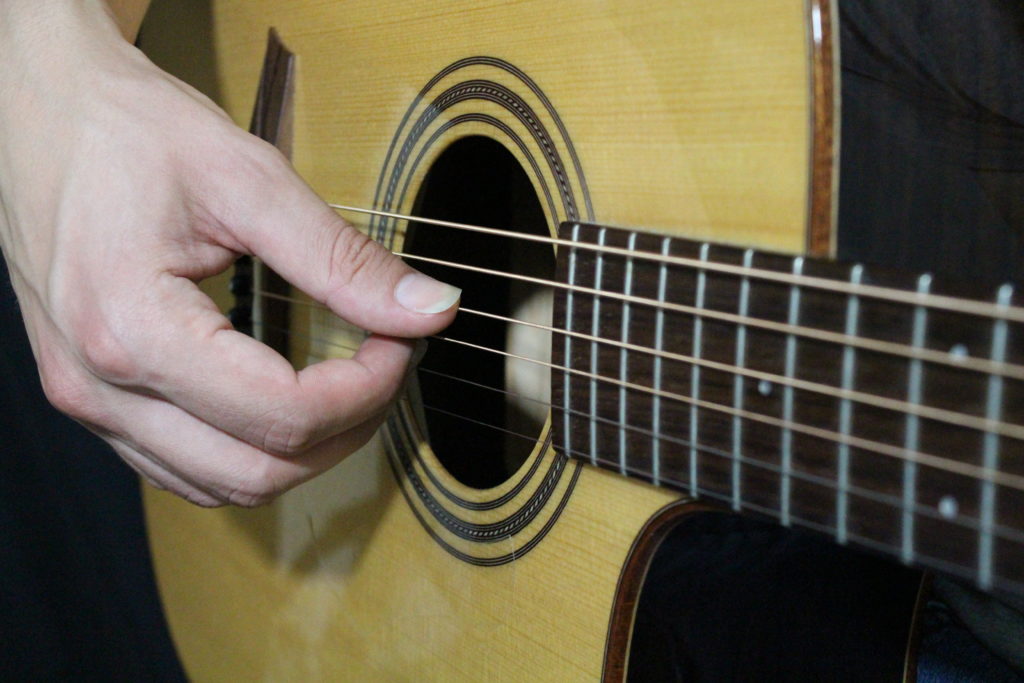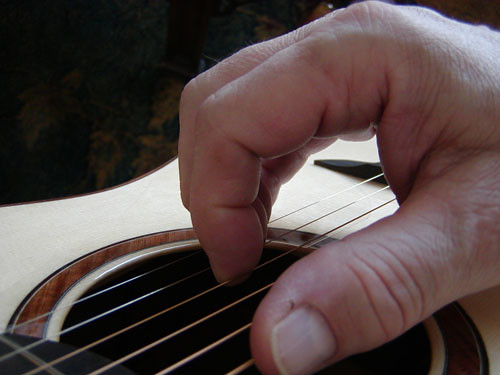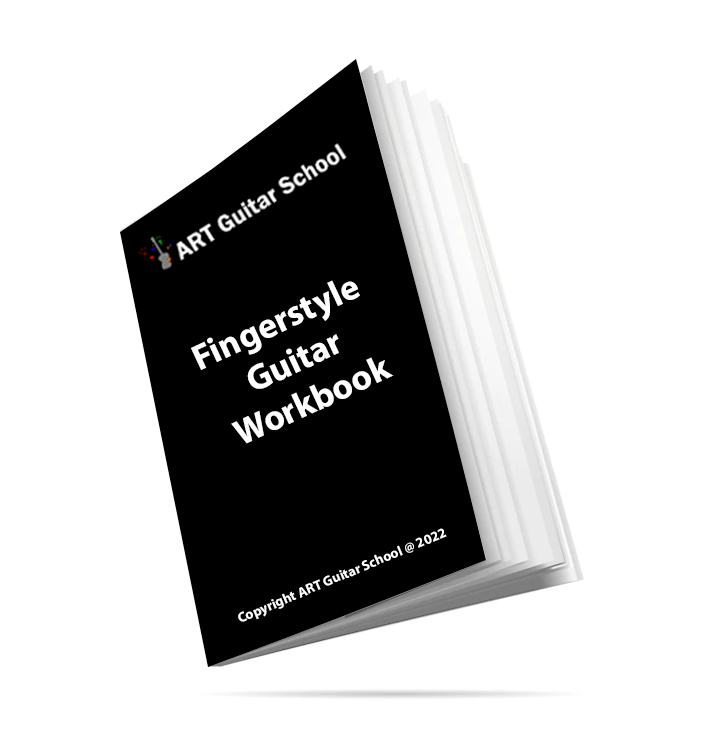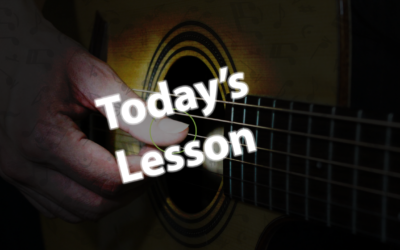One of the most common questions that arise when discussing fingerstyle is if you should use nails or flesh when playing.
Nails require you to either grow out your fingernail or apply acrylics whereas flesh doesn’t require any additional maintenance except for cutting the nails.
You may be asking, what are the main differences and advantages/disadvantages between the two?
Nails
Right off the bat, nails are going to provide a brighter tone due to the material that is striking through the string. With proper shaping and filing technique the nails could provide a warmer tone. This requires several adjustments with the filing of the nail in order for the nail to come out just right for your specific right hand technique. There are many different angles & approaches but all have the same principle.
This picture demonstrates a good nail length and shaping to start with:
Flesh
This route is the most common to start with, as it doesn’t require any additional work in order to play fingerpicking guitar. If we forget the nails and disregard any artificial product we use our flesh to fingerpick. The flesh provides a much warmer tone and less volume as well as dynamic range since it’s not likely to project as well as nails.

Here is a video on nail shaping I recommend:
Deciding on your nails or flesh is based on your personal taste and the sound that you’re trying to achieve. If you were a fingerstyle player or classical guitar player it is recommended that you at least try the nails and see if they’re a good fit for you. If you have brittle nails, there are hardening products and vitamins that can help to be able to strengthen them.
Learn more about technique through our FREE Fingerstyle Workbook!
FOLLOW US ON
Get our FREE Fingerstyle Workbook!
RELATED BLOG POSTS
Exploring Alternate Tunings for Fingerstyle Guitar
Exploring alternate tunings can significantly expand your fingerstyle guitar repertoire. By tuning your guitar differently, you can unlock new voicings, chords, and melodic possibilities. Here are some popular alternate tunings to try and how they can enhance your fingerstyle playing.
Drop D tuning (D A D G B E) is a favorite among fingerstyle guitarists. This tuning allows for easy access to powerful bass notes while maintaining familiar chord shapes. Experiment with fingerpicking patterns that emphasize the bass string, creating a rich, full sound.
Open G tuning (D G D G B D) offers a unique sonic palette. This tuning is ideal for slide guitar and folk music, allowing for smooth transitions between chords. It’s great for creating resonant melodies that ring out beautifully when fingerpicked.
DADGAD tuning is another excellent option for fingerstyle guitarists. This tuning creates a modal sound that is perfect for Celtic and folk music. It enables the use of drone notes and open strings, adding depth and resonance to your playing.
When exploring these alternate tunings, start by familiarizing yourself with the chord shapes and fingerpicking patterns unique to each. Practice switching between different tunings to discover new sounds and textures.
Experimentation is key when it comes to alternate tunings. Don’t hesitate to create your own tunings based on what inspires you. With practice, these alternate tunings can add a fresh dimension to your fingerstyle guitar playing.
Using Fingerstyle to Create Dynamic Contrasts in Playing
Fingerstyle guitar offers a unique opportunity to create dynamic contrasts in your playing. This technique allows for expressive nuances, enabling you to convey a wide range of emotions through your music. Here’s how to utilize fingerstyle for dynamic contrasts effectively.
Start by exploring the concept of palm muting. By lightly resting your palm on the strings while plucking, you can produce a softer, muted sound. This technique is excellent for creating tension in a piece, which can be released when you play louder and more freely.
Incorporate varying finger techniques to achieve different dynamics. For instance, use your thumb for deeper bass notes and your fingers for higher-pitched melodies. This contrast not only enriches your sound but also enhances the overall texture of your playing.
Experiment with articulation. Accents can be added to specific notes to create emphasis, leading to a more dynamic performance. Practice accenting the first beat of each measure or specific melody notes to draw attention to them.
Use volume swells by gradually increasing or decreasing the intensity of your playing. This can be achieved through your finger pressure and speed. Slow, gentle plucking can create a soft, delicate sound, while vigorous strumming can yield a powerful, bold tone.
Finally, practice transitioning between soft and loud passages seamlessly. This will allow you to create compelling contrasts in your music, captivating your audience and enhancing your expressive capabilities.
Practicing Fingerstyle with a Metronome: Tips and Tricks
Using a metronome is a valuable tool for any guitarist, especially for those focusing on fingerstyle techniques. It helps develop timing, rhythm, and precision, which are crucial for mastering this playing style. Here are some tips to effectively practice fingerstyle with a metronome.
Start by setting the metronome at a slow tempo. This allows you to focus on playing each note cleanly and accurately. As you gain confidence, gradually increase the tempo. It’s essential to maintain a steady rhythm, so resist the urge to rush.
Break your practice into sections. For example, if you’re learning a new fingerstyle pattern, practice it slowly at first. Once you feel comfortable, incorporate the metronome to solidify your timing.
Use the metronome to emphasize specific beats. For instance, set it to click on the first and third beats of a measure. This helps you develop a strong sense of downbeats, which is crucial in fingerstyle playing.
Incorporate dynamic variations by adjusting the volume of your playing in relation to the metronome. Play softly on some beats and louder on others to create a more dynamic performance.
Lastly, be patient and consistent in your practice. Working with a metronome may feel challenging at first, but with dedication, you’ll see significant improvements in your fingerstyle technique and timing.





0 Comments